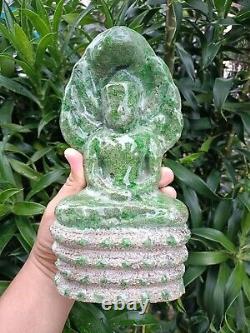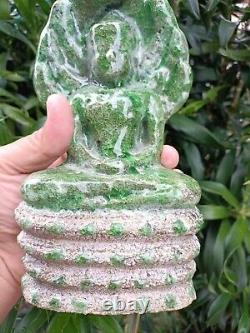Naga Prok Buddha statue, Thai amulet made from clay #2












Naga Prok Buddha statue, Thai amulet made from clay. There is a genuine inspection from an amulet.
We deliver products by Thailand Post. Make it loved and have a loved one with a lot of mercy. Will make the business prosperous and prosperous.For those who trade and want to increase business sales. The story and the divine power of this amulet. When the Lord Buddha had sat down and enjoyed his liberation in the shade of the Ashpal Nigrod tree for 7 days, then he went to sit and enjoy the liberation in the shade of a poked tree called Mutjalin, which is located on the southeast side of the Phra Sri Maha Bodhi tree.
On that day, it rained uninterruptedly for 7 days. The king of the naga got out of the serpent Make a hair around the body 7 layers and spread a large roost covering the top. Like blocking the veneration of the Blessed One with the intention of preventing rain and cold wind from splashing upon His body It protects against flies, mosquitoes, slugs, slugs, gnats, and all reptiles. The rain is gone Phaya Muchhalin, the Naga, thus loosening his hair from surrounding the Buddha's body. Transgendered as a young man, standing in front of him, making an altar to pay homage to the Buddha Then the Blessed One exclaimed, "Suko Viveko Tutthassa Sutadhammassa Passato Apyaphajjang Sukhang Loke panabhutesu Jajamo suka viragata loke kamanam samatikkamo asmimanassa vinayo etam ve ramang sukhang", saying, The bliss of a person who has heard the Dharma.Already How do you see all sankharas as they really are? Unobtrusiveness is the composure in all animals. And a person without desire is the transgression of all sexual desires.
Blessed are the worlds of elimination which Asmin mana. Is that this self-confidence is the greatest happiness. The Buddha Jariya, sitting in the serene serenity of the serpent serpent serpent, Mujalin, who is curled around his body. This is the reason why the Buddha image was built in this posture, called the Naga Prok Pang. Popularly built as a monk sitting on the body of a serpent like a serpent as a throne, looks elegant.
Ong may be one of His glory. Has the appearance of a brahmin god If to maintain the characteristics of the Buddha image according to the history It will be in another way. The Buddha image has a serpent wrapped around his body with 4-5 pieces of serpent hair until it completely covers his body.
To prevent rain and wind It can be seen that only the head, neck and Phra Angsa are very much. Above, there was also a serpent's head spreading over the roof. This Buddha image in the posture of Naga Prok is popularly built as Buddha images worshiped daily for people born on Saturday. In Buddhism, it is known that the Buddha image in the posture of Naga Prok is widely known. Related to a serpent named "Muchlin" who came to spread the canopy to protect the Buddha and became a monk of Saturday In addition to the story of the serpent worshiping in Buddhism to the extent that he disguised himself to ask for ordination until he was called "ordained naga" until today. Phra Nak Prok is like a serpent that has spread over the ridge. Protect the destiny from suffering and disasters And there is also a belief that this pang is sacred through mercy. Which is an indirect teaching to see the merits or benefits of kindness because even the Naga came up from the pond to offer protection to the Lord Buddha This is due to the power of His Majesty's grace, the worship of Phra Nak Prok, in order to arouse longevity, enhance the fortune, have mercy, great wealth, great power, good in every aspect for the worshiper. Bringing Phra Nak Prok or the birthday amulet Worship should be at the head of one's own bed is the best. The Lord will protect you from all dangers.As if you were protected all the time. Chant 10 endings (Angulimalaparita) as follows: "Yatohang Bhakini Ariyaya Chataya Chato Naphi Chanami Sanchica Panang Chitiya Voropetta Tena Saccana Sotthi Te hotu sotthi kappassa" There are some beliefs.
Believe that the origin of the Buddha image in this posture It is a blend of beliefs of two religions, Buddhism and Hinduism. With origins from Vishnu or Vishnu while lying on the seat of a serpent at the navel of the sea.

